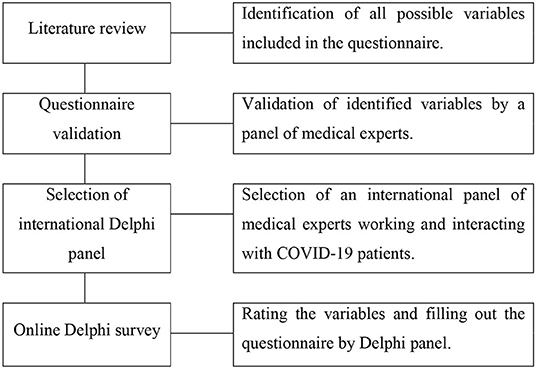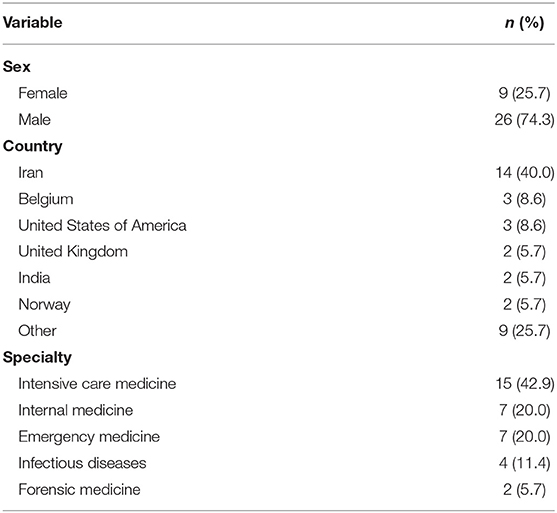- Social Determinants of Health Research Center, Shahid Beheshti University of Medical Sciences, Tehran, Iran
Background: COVID-19 pandemic has resulted in severe shortage in vital resources, including invasive mechanical ventilators. The current imbalance between demand and supply of mechanical ventilators has called for investigations on the fair allocation of mechanical ventilators.
Objective: To determine the priorities of the medical experts towards the fair allocation of ventilators during the COVID-19 pandemic.
Methods: This study was conducted from May 28 to Aug 20, 2020. The questionnaire was sent to 50 medical specialists as the Delphi panel. Participants were asked to rate each prioritising factor: “−1” for low priority, “+1” for high priority, and “Zero” for equal priority.
Results: Among 38 experts who responded to the email, the responses of 35 were analysed. 31 (88.6%) participants recommended that pregnant women be considered high priority in allocating ventilators, 27 (77.1%) mothers of children <5 years, 26 (74.3%) patients under 80-years, and 23 (65.7%) front-line-healthcare-workers. In contrast, 28 (80.0) participants recommended that patients who are terminally ill should be considered as a low priority, 27 (77.1%) patients with active-malignancy, 25 (71.4%) neurodegenerative diseases, and 16 (45.7%) patients aged >80. The panel did not reach a consensus regarding the role of patients' laboratory profiles, underlying diseases, or drug abuse in the prioritisation of ventilators.
Conclusions: The panel considered pregnant mothers, mothers of children under 5 years, age groups younger than 80, and front-line healthcare workers to have high priority in allocating mechanical ventilators.
Introduction
The coronavirus disease 2019 (COVID-19) pandemic is rapidly intensifying worldwide and continues to place an extraordinary burden on humankind (1). Since the early days of the pandemic, a severe shortage in vital resources, including invasive mechanical ventilators, has remained a significant concern of healthcare professionals (2, 3).
During the pandemic, of all patients diagnosed with COVID-19, 17–35% required hospitalisation at ICUs (4, 5) and 9–19% required invasive mechanical ventilation (4, 6). The estimated number of invasive mechanical ventilators in various countries would not be adequate to serve all clinically eligible patients during the current pandemic (3). Therefore, the current imbalance between demand and supply of mechanical ventilators has called for investigations on the fair allocation of mechanical ventilators. Although the research has been ongoing on the subject since the early days of the pandemic, significant concerns remain controversial (7–9).
Medical experts working at the COVID-19 care units interact with patients of different socioeconomic, clinical, paraclinical, and overall health statuses. Nevertheless, physicians should not be faced with situations where they would be obliged to decide which patient to treat due to the risk of human error and the life-long emotional toll (10). Therefore, prioritisation recommendations and guidelines are being developed in the hope of helping physicians, especially those less experienced, with the real-time decision-making process based on the resources and contexts (11, 12). Nevertheless, most studies on the subject have focused on experts' opinions from a single country or region, limiting their generalizability (7–9).
The objective of this study was to determine the priorities of the medical experts towards the fair allocation of ventilators during the COVID-19 pandemic via an international online Delphi survey.
Materials and Methods
This online Delphi survey has been approved by the Ethical Committee of Shahid Beheshti University of Medical Sciences, Tehran, Iran, under the reference code IR.SBMU.RETECH.REC.1399.103. Participation was anonymous and upon the participant's own decision.
Review of Literature and Expert Selection
This study was conducted from May 28 to Aug 20, 2020. To design the Delphi questionnaire, an extensive literature review was conducted by the authors. The explored resources for data collection included the Centres for Disease Control (CDC), World Health Organisation (WHO), Infectious Diseases Society of America (IDSA), and European Centre for Disease Prevention and Control (ECDC). Electronic databases including PubMed, EMBASE, Medline, and Cochrane library were precisely investigated using the terms: COVID-19, SARS-CoV-2, mechanical ventilation, prioritisation, healthcare rationing, ethics, health policy, resource allocation, and invasive mechanical ventilators. After the initial preparation of the questionnaire, the Delphi survey was conducted in two phases.
Firstly, an expert panel of 10 individuals, two public health experts, two anesthesiologists, two emergency medicine specialists, two pulmonologists, and two infectious diseases specialists were asked to evaluate the questionnaire and provide other potential variables. The invitation link to participate was sent via email with a brief description of the aim of the study. Data were gathered through an online questionnaire via the Google Form platform.
Secondly, the revised version of the questionnaire based on the comments of the first-phase panellists was sent to a group of 50 medical specialists as our Delphi panel. All potential members were professionally involved in managing the patients with COVID-19 during the pandemic and were identified by investigating their professional academic curriculum vitae and the acquaintance of authors with them. Of them, 20 were intensive care experts, 10 were internal medicine specialists, 10 were emergency medicine specialists, 5 were forensic medicine experts, and 5 were infectious diseases specialists worldwide. Like the first phase, an email explaining the objective of the survey, their involvement in the study, how the Delphi study works, and the invitation link was sent to each potential participant. Among all participants who received the invitation email, 38 (76% response rate) agreed to participate in the study. Responses of three participants were incomplete, and therefore responses of 35 participants were analysed. Participants' responses in the second phase were considered as final responses. The authors of the article and the medical experts who contributed in the first phase were not included in the Delphi panel (Figure 1).
Variables and the Questionnaire
Variables included the personal information of the participants and the criteria for prioritising the ventilators during the pandemic. Personal information included participants' gender, age, area of study or speciality, affiliated institution, country, and the ventilator allocation experience in a setting of scarcity during the COVID-19 pandemic.
Among the criteria of prioritising the mechanical ventilators during the pandemic, all potential factors associated with the poor outcome of COVID-19 and the social responsibility of the patient were included and being divided into four sections: (1) non-medical determinants, (2) the underlying health conditions, (3) clinical, and (4) paraclinical presentation of COVID-19. It is worth mentioning that gender differences, religious beliefs, various nationalities, chronic disabilities, and being refugees or immigrants were not included among the criteria of prioritising the mechanical ventilators due to ethical considerations (12).
Among non-medical determinants, various age groups of the patients, being healthcare professionals, smoking status, drug abuse, and being the mother of a child under 5 years were included. Giving the significance of various age groups in COVID-19 prognosis, age groups of patients were considered in eight different groups including below 19, 20 to 49 years, 50–59 years, 60–69 years, 70–74 years, 75–79 years, 80–84 years and above 85 years (13).
The underlying health conditions section included 12 health conditions, which would exacerbate the COVID-19 status of the patient. Obesity, pregnancy, uncontrolled hypertension, ischemic heart disease, poorly controlled diabetes mellitus, chronic kidney disease, neurodegenerative diseases, chronic respiratory failure, organ transplantation, hepatic failure, active malignancy, receiving immunosuppressive therapy, and being infected by Human Immunodeficiency Virus (HIV) were significant factors.
In the third and fourth sections, all clinical and paraclinical presentations of COVID-19 associated with the poor prognosis of the COVID-19 were included. Clinical presentations included clinicians' overall assessment of the COVID-19 prognosis based on the frailty scale (14), hypoxia based on disparate levels of oxygen saturation (SpO2), hypotension and organ failure based on mean arterial pressure (MAP), the dosage of vasoactive agents required, having disseminated intravascular coagulation (DIC) and cardiac arrest. Paraclinical presentation of patients was included leukopenia, lymphopenia, low platelet counts, high bilirubin, creatinine, lactate-dehydrogenase (LDH), troponin, erythrocyte sedimentation rate (ESR), C-reactive protein (CPR), ferritin, and D-dimer.
Data Analysis
To quantify the opinions of the Delphi panel, we asked the participants to rate each prioritising factor based on three scores; “−1” was considered as low priority, “+1” high priority, and “Zero” which indicated that the factor should not be deciding at all and was considered “equal priority.” The central tendency statistics, including mean, median, and mode, in addition to 95% confidence intervals (95% CI), standard deviation (SD), interquartile ranges (IQR), and skewness, were reported. The Mann-Whitney U test and Kruskal-Wallis one-way analysis of variance tests were applied to define the differences between the means of two groups and three groups or more, respectively. Statistical analyses were performed using IBM SPSS Statistics 21. A probability level of <0.05 was considered significant.
Results
Of 38 participants, responses of 35 (92.1%) participants were analysed. The mean (SD) age of participants was 50.1 (9.0), range 39–78, being 51.2 (9.8) among men and 47.2 (5.4) among women. Among participants, 22 (64.7%) declared that they had not encountered the situation of deciding to allocate invasive mechanical ventilators in the setting of scarcity during the COVID-19 pandemic. Other sociodemographic characteristics of participants are presented in Table 1.
Among various non-medical prioritising determinants, most participants believed that younger ages, healthcare workers, and the mothers of children under 5 years should be considered a high priority in allocating mechanical ventilators. As many as 26 (74.3%) participants reported high priority for patients under 80 years of age; however, 16 (45.7%) participants said they would give lower priority to patients aged 80 or more. There was no consensus regarding the prioritisation of ventilator allocation for patients' smoking and drug abuse status (Table 2).
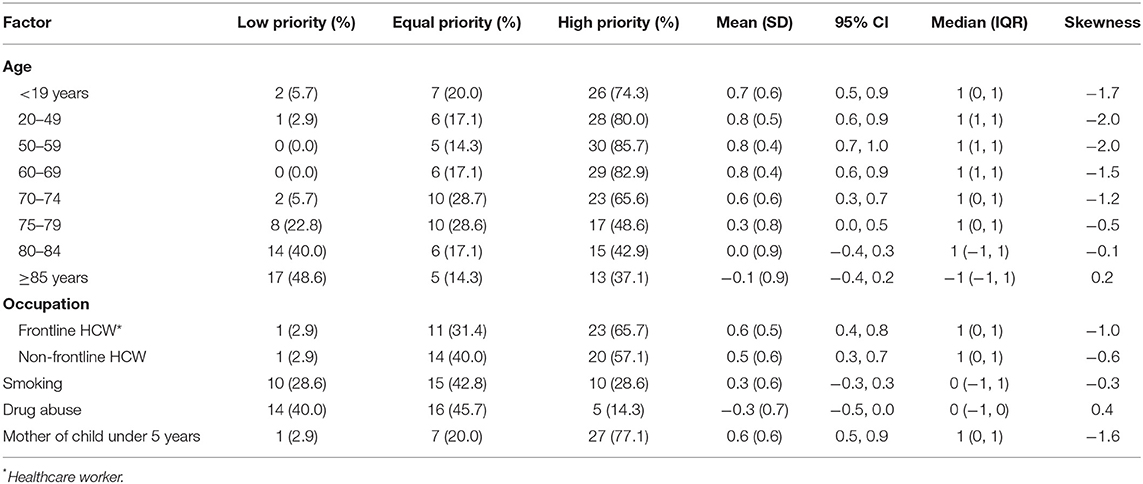
Table 2. Responses on prioritising ventilator allocation regarding non-medical characteristics of patients.
When the Delphi panel was asked to prioritise patients regarding their underlying health condition, 31 (88.6%) participants recommended that pregnant women take high priority. Among underlying diseases, 27 (77.1%) and 25 (71.4%) participants reported low priority for active malignancy and neurodegenerative diseases, respectively. Although patients with BMI>40, diabetes mellitus, chronic kidney disease, and chronic respiratory failure received low priority, the number of participants reporting high or equal priority for the diseases was high as well. The participants' responses on prioritising ventilator allocation regarding underlying health conditions are presented in Table 3.

Table 3. Responses on prioritising ventilator allocation regarding the underlying health condition of patients.
While the Delphi panel assigned a high priority for hypotensive and hypoxic patients, the end stages of hypotension, including DIC and cardiac arrest, received lower priority. Considering the clinician's judgment about the prognosis of COVID-19 based on the frailty scale, severely frail and terminally ill patients were given lower priority than very fit, well, and managing well patients (Table 4).
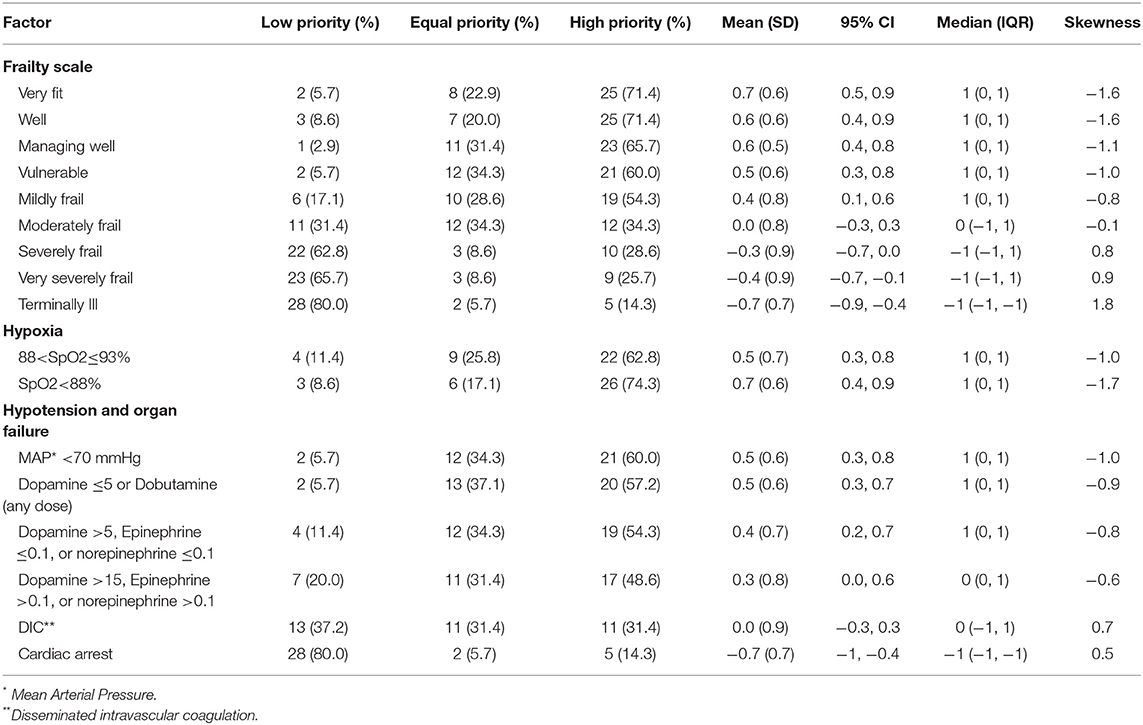
Table 4. Responses on prioritising ventilator allocation regarding clinical presentation of COVID-19.
Considering the importance of paraclinical factors in anticipating the prognosis of COVID-19 among patients, we asked the panellists to rate every paraclinical factor, including blood cell counts, liver and kidney function tests, inflammatory factors, troponin, and D-dimer tests. The majority of paraclinical factors associated with the severity of COVID-19 were considered unimportant in resource allocation by panellists (Table 5).
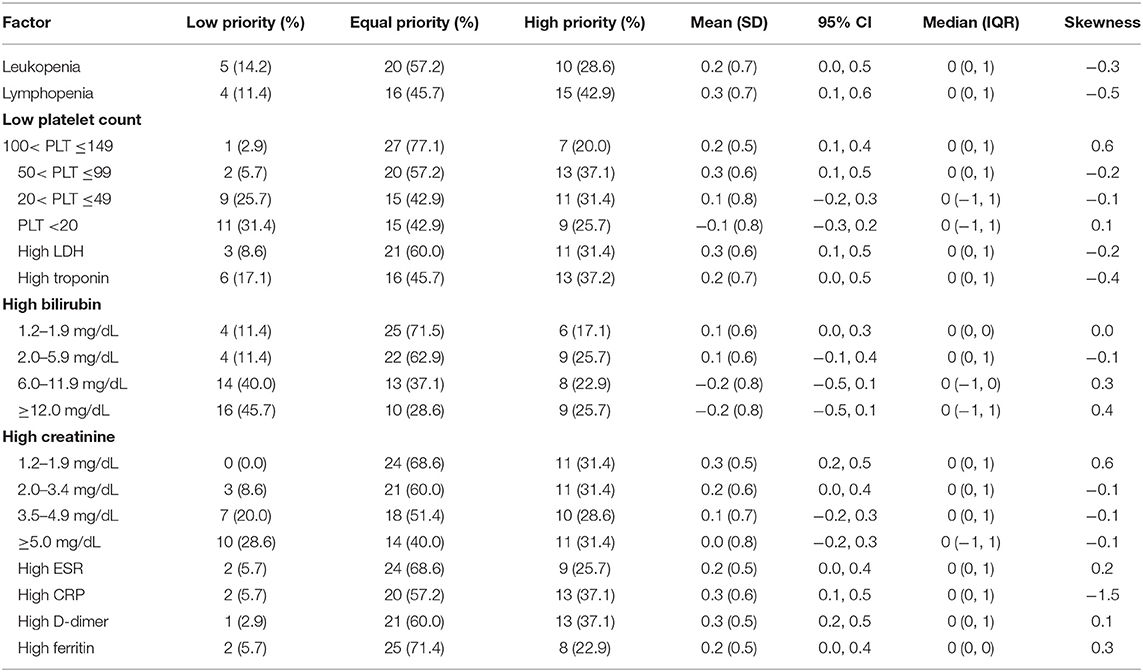
Table 5. Responses on prioritising ventilator allocation regarding laboratory presentation of COVID-19.
No correlations were observed with participants' responses on resources allocation and their age, religion, country of residence, the field of study, and the dilemma of allocating invasive mechanical ventilators in the setting of scarcity during the COVID-19 pandemic.
Discussion
The study showed that the panel considered younger age groups, healthcare workers, and mothers of children under 5 years for prioritising mechanical ventilators. While most participants reported high priority for patients under 80 years of age, almost half of participants said they would give lower priority to patients aged 80 or more. There was no consensus regarding the prioritisation of ventilator allocation for patients' smoking and drug abuse status.
Some 89% of participants recommended that pregnant women must take high priority. Many guidelines also prioritised pregnant women, younger age groups, and healthcare professionals to allocate ventilators (15). There is evidence that the mortality due to COVID-19 is lower among younger age groups. Nevertheless, young hospitalised patients with COVID-19 regularly require ventilators for extended periods (16). Thus, cohort and investigational studies could help healthcare professionals and experts.
Although patients with BMI>40, diabetes mellitus, chronic kidney disease, and chronic respiratory failure received low priority, the number of participants reporting high or equal priority for the diseases was high as well. While the panel considered a high priority for hypotensive and hypoxic patients, the end stages of hypotension, including DIC and cardiac arrest, received lower priority.
More than two-thirds of participants considered patients with active malignancy and neurodegenerative diseases to have low priority. COVID-19 pandemic has disrupted the conventional care delivery for both malignancies and neurodegenerative diseases (17, 18). Patients with neurodegenerative diseases, which is more common among advanced age groups (19), often live in residential homes, which puts them at greater risk of COVID-19 transmission (20). Similar to considering these groups as low-priority in our study, many resource allocation guidelines have excluded these patients (21), which could put them at risk of systemic discrimination in the near future (22).
Among underlying diseases, COPD is reported to be an independent risk factor for all-cause mortality among patients with COVID-19 (23). Hypertension and uncontrolled hypertension were the most common comorbidity among hospitalised patients with COVID-19 infection (24).
The majority of paraclinical factors associated with the severity of COVID-19 were considered unimportant in resource allocation. There is evidence that LDH and CRP independently predicted ventilation requirements among COVID-19 patients (16).
Considering the clinician's judgment about the prognosis of COVID-19 based on the frailty scale, severely frail and terminally ill patients were given lower priority than very fit, well, and managing well patients. Evidence shows that the frailty scale is linearly associated with increased mortality due to COVID-19 (25). Although some studies proposed using Sequential Organ Failure Assessment (SOFA) score for prioritising ventilator allocation in the early days of the pandemic (26), the SOFA score has been shown to have inadequate accuracy for ventilator triage of patients with COVID-19 (27). The combination of the frailty scale with the SOFA score did not improve the performance of the SOFA score either (28). Thus, better alternatives are needed for prognostic prediction of patients with COVID-19 pneumonia requiring mechanical ventilation.
Unresolved ethical dilemmas regarding the fair allocation of ventilators threaten the success of the response to a public health emergency. Nevertheless, not all healthcare systems have developed allocation guidelines (26, 29, 30). Some studies challenge the “save the most lives” strategy. A study proposes that the following considerations be taken into account, when necessary while allocating scarce resources: maximising survival to hospital discharge, maximising the number of life-years saved, maximising individuals' chances to live through each of life's stages, the severity of impairment, and patients' instrumental value into prioritisation considerations. In this sense, the public also needs to participate in choosing among ethically permissible allocation strategies (7, 31). Some studies have investigated people's opinions on the fair allocation of ventilators (32). A community-based survey reported that people considered age, expected ventilation effectiveness, smoking status, having dependents, being a healthcare worker, and having disabilities to be of importance in resource allocation (33).
Strengths and Limitations
This is among the few studies investigating the experts' opinions on priorities towards fair allocation of mechanical ventilators during the COVID-19 pandemic. Findings could empower public health authorities better to understand experts' opinions to be considered in future guidelines. It is worth mentioning that the COVID-19 pandemic disrupted the supply chain of medical resources, which was only successful when demand was predictable (34). Focusing on the fair allocation of ventilators during this crisis should not distract the authorities from optimising the supply chain.
We realise the limitations of the study. The number of participants was limited; however, the pandemic disrupted people's daily schedule worldwide, and experts were no exception (35). Nevertheless, given the response rate, the generalisation of results could be limited. Considering that the panel was approached based on the acquaintance of authors, our sample was over-representative of colleagues in the authors' network. Using the authors' network would increase the chance of the panel's participation in the study, given that experts would be too busy during the pandemic and would probably ignore emails from unfamiliar senders. While the study had a poor representation of some regions, especially considering different social, religious and healthcare systems approaches, the findings could be used as a basis for a broader represented experts' panel.
Conclusion
The panel considered younger age groups, healthcare workers, pregnant mothers, and mothers of children under 5 years for prioritising mechanical ventilators. There was no general consensus regarding the prioritisation of ventilator allocation based on the patient's laboratory profile, underlying diseases, or drug abuse. It could be suggested that more research is essential to develop comprehensive resource allocation strategies which are easy to apply, objective, accurate, reproducible, and would not discriminate against vulnerable populations.
Data Availability Statement
The raw data supporting the conclusions of this article will be made available by the authors, without undue reservation.
Ethics Statement
The studies involving human participants were reviewed and approved by Ethical Committee of Shahid Beheshti University of Medical Sciences, Tehran, Iran under the reference code IR.SBMU.RETECH.REC.1399.103. Written informed consent for participation was not required for this study in accordance with the national legislation and the institutional requirements.
Author Contributions
A-AK, NZ, HH-M, S-HG, and MA-K: study conception and design. A-AK, S-HG, and MA-K: acquisition, analysis, or interpretation of data. S-HG and MA-K: drafting of the manuscript. A-AK, HH-M, and NZ: critical revision of the manuscript for important intellectual content. A-AK: study supervision. The corresponding authors attests that all listed authors meet the authorship criteria and that no others meeting the criteria have been omitted. All authors contributed to the article and approved the submitted version.
Funding
This study was supported by Social Determinants of Health Research Center, Shahid Beheshti University of Medical Sciences, Tehran, Iran under code 23526. The funding body was not in any ways involved in the design of the study and collection, analysis, and interpretation of data and in writing the manuscript.
Conflict of Interest
The authors declare that the research was conducted in the absence of any commercial or financial relationships that could be construed as a potential conflict of interest.
Publisher's Note
All claims expressed in this article are solely those of the authors and do not necessarily represent those of their affiliated organizations, or those of the publisher, the editors and the reviewers. Any product that may be evaluated in this article, or claim that may be made by its manufacturer, is not guaranteed or endorsed by the publisher.
Acknowledgments
The authors would like to express their profound gratitude to all 38 medical experts for participating in this Delphi survey and for sharing their precious knowledge and experience. Special thanks to: Cynthia Aaron (Emergency Medicine Department, Michigan Poison Center, Detroit, USA); Kurt Anseeuw (Emergency Medicine Department, Ziekenhuis Netwerk Antwerpen (ZNA), Antwerp, Belgium); Mahdi Balali-Mood (Clinical Toxicology Department, Mashhad University of Medical Sciences, Mashhad, Iran); Shabnam Bazmi (Medical Ethics Department, Shahid Beheshti University of Medical Sciences, Tehran, Iran); Ashish Bhalla (Internal Medicine Department, PGIMER, Chandigarh, India.); Jeffrey Brent (School of Medicine, University of Colorado, Denver, USA); Ilad Alavi Darazam (Infectious Diseases Department, Shahid Beheshti University of Medical Sciences, Tehran, Iran); Paul I Dargan (Clinical Toxicology Department, Guy's and St Thomas' NHS Foundation Trust, London, UK); Dylan W De Lange (Intensive Care Unit, UMC Utrecht, Utrecht, Netherlands); Peter De Paepe (Emergency Department, Ghent University Hospital, Ghent, Belgium); Hamideh Esalati (Ghaem Hospital, Mashhad University of Medical Sciences, Mashhad, Iran); Florian Eyer (Department of Clinical Toxicology Poisons Control Centre Munich, TUM School of Medicine, Klinikum rechts der Isar, Technical University of Munich, Munich, Germany); Marc Ghannoum (Nephrology Department, University of Montreal, Montreal, Canada); Mohammadreza Hajiesmaeili (Anesthesiology Department, Shahid Beheshti University of Medical Science, Tehran, Iran); Philippe Hantson (Intensive Care Unit, Cliniques St-Luc, Université catholique de Louvain, Brussels, Belgium); Fridtjof Heyerdahl (Air Ambulance Department, Oslo University Hospital, Oslo, Norway); Knut Erik Hovda (Department of Acute Medicine, Oslo University Hospital, Oslo, Norway); Mehrzad Kiani (Medical Ethics Department, Shahid Beheshti University of Medical Sciences, Tehran, Iran); Ata Mahmoodpoor (Anesthesiology Department, Tabriz University of Medical Sciences, Tehran, Iran); Alex Manini (Emergency Medicine Department, Icahn School of Medicine at Mount Sinai, New York, USA); Bruno Megarbane (Medical and Toxicological Critical Care Department, Lariboisiere Hospital, Paris, France); Amirhossein Mirafzal (Emergency Medicine Department, Kerman University of Medical Sciences, Kerman, Iran); Majid Mokhtari (Department of Pulmonary and Critical Care Medicine, Loghman Hakim Hospital, Shahid Beheshti University of Medical Sciences, Tehran, Iran); Viorela Nitescu (Toxicology Intensive Care, Emergency Clinical Hospital for Children “Grigore Alexandrescu”, Bucharest, Romania); Marlies Ostermann (Clinical Toxicology Department, Guy's and St Thomas' NHS Foundation Trust, London, UK); Raido Paasma (Department of Anesthesia and ICU, Foundation Pärnu Hospital, Pärnu, Estonia); Darren Roberts (Renal Medicine and Transplantation, and Clinical Pharmacology and Toxicology, St Vincent's Hospital, Sydney, Australia); Emilio Salgado (Emergency Department, Hospital Clinic Barcelona, Barcelona, Spain); Mohsen Savaie (Anesthesiology and Critical Care, Ahvaz Jundishapur University of Medical Sciences, Ahvaz, Iran); Bhavesh Seerubhai Jarwani (Emergency Medicine Department, Smt. NHLM Medical College, SVP hospital, Ahmedabad, India); Kamran Shadvar (Anesthesiology Department, Tabriz University of Medical Sciences, Tabriz, Iran); Seyedpouzhia Shojaei (Department of Critical Care Medicine, Imam Hossein Medical and Educational Center, Shahid Beheshti University of Medical Sciences, Tehran, Iran); Shervin Shokouhi (Infectious Diseases Department, Loghman Hakim Hospital, Shahid Beheshti University of Medical Sciences, Tehran, Iran); Roberto Zoppellari (Anesthesiology Department, S. Anna Hospital, Ferrara, Italy).
References
1. Mehta S, Machado F, Kwizera A, Papazian L, Moss M, Azoulay É, et al. COVID-19: a heavy toll on healthcare workers. Lancet Respir Med. (2021) 9:226–8. doi: 10.1016/S2213-2600(21)00068-0
2. Zhou W, Wang A, Wang X, Cheke RA, Xiao Y, Tang S. Impact of hospital bed shortages on the containment of covid-19 in wuhan. Int J Environ Res Public Health. (2020) 17:1–18. doi: 10.3390/ijerph17228560
3. Dos Santos MJ, Martins MS, Santana FLP, Furtado MCSPC, Miname FCBR, Pimentel RRDS, et al. COVID-19: Instruments for the allocation of mechanical ventilators- a narrative review. Crit Care. (2020) 24:582. doi: 10.1186/s13054-020-03298-3
4. Potere N, Valeriani E, Candeloro M, Tana M, Porreca E, Abbate A, et al. Acute complications and mortality in hospitalised patients with coronavirus disease 2019: a systematic review and meta-analysis. Crit Care. (2020) 24:389. doi: 10.1186/s13054-020-03022-1
5. Docherty AB, Harrison EM, Green CA, Hardwick HE, Pius R, Norman L, et al. Features of 20 133 UK patients in hospital with covid-19 using the ISARIC WHO Clinical Characterisation Protocol: Prospective observational cohort study. BMJ. (2020) 369:m1985. doi: 10.1136/bmj.m1985
6. Grant MC, Geoghegan L, Arbyn M, Mohammed Z, McGuinness L, Clarke EL, et al. The prevalence of symptoms in 24,410 adults infected by the novel coronavirus (SARS-CoV-2; COVID-19): a systematic review and meta-analysis of 148 studies from 9 countries. PLoS ONE. (2020) 15:e0234765. doi: 10.2139/ssrn.3582819
7. White DB, Katz MH, Luce JM, Lo B. Who should receive life support during a public health emergency? Using ethical principles to improve allocation decisions. Ann Intern Med. (2009) 150:132–8. doi: 10.7326/0003-4819-150-2-200901200-00011
8. Peterson A, Largent EA, Karlawish J. Ethics of reallocating ventilators in the covid-19 pandemic. BMJ. (2020) 369:m1828. doi: 10.1136/bmj.m1828
9. Wicclair M. Allocating ventilators during the COVID-19 pandemic and conscientious objection. Am J Bioeth. (2020) 20:204–7. doi: 10.1080/15265161.2020.1777347
10. The Lancet. COVID-19: protecting healthcare workers. Lancet. (2020) 395:922. doi: 10.1016/S0140-6736(20)30644-9
11. Emanuel EJ, Persad G, Upshur R, Thome B, Parker M, Glickman A, et al. Fair allocation of scarce medical resources in the time of Covid-19. N Engl J Med. (2020) 382:2049–55. doi: 10.1056/NEJMsb2005114
12. Swiss Academy Of Medical Sciences. COVID-19 pandemic: triage for intensive-care treatment under resource scarcity. Swiss Med Wkly. (2020) 150:w20229. doi: 10.4414/smw.2020.20229
13. Undurraga EA, Chowell G, Mizumoto K. COVID-19 case fatality risk by age and gender in a high testing setting in Latin America: Chile, March–August 2020. Infect Dis Poverty. (2021) 10:11. doi: 10.1186/s40249-020-00785-1
14. Sablerolles RSG, Lafeber M, van Kempen JAL, van de Loo BPA, Boersma E, Rietdijk WJR, et al. Association between Clinical Frailty Scale score and hospital mortality in adult patients with COVID-19 (COMET): an international, multicentre, retrospective, observational cohort study. Lancet Heal Longev. (2021) 2:e163–70. doi: 10.1016/S2666-7568(21)00006-4
15. Wunsch H, Hill AD, Bosch N, Adhikari NKJ, Rubenfeld G, Walkey A, et al. Comparison of 2 triage scoring guidelines for allocation of mechanical ventilators. JAMA Netw open. (2020) 3:e2029250. doi: 10.1001/jamanetworkopen.2020.29250
16. Nicholson CJ, Wooster L, Sigurslid HH, Li RH, Jiang W, Tian W, et al. Estimating risk of mechanical ventilation and in-hospital mortality among adult COVID-19 patients admitted to Mass General Brigham: the VICE and DICE scores. EClinicalMedicine. (2021) 33:100765. doi: 10.1016/j.eclinm.2021.100765
17. Berardelli A, Silani V, Barone P, Calabresi P, Girlanda P, Lopiano L, et al. Neurology and the COVID-19 emergency. Neurol Sci. (2020) 41:1343–4. doi: 10.1007/s10072-020-04465-8
18. Neal RD, Nekhlyudov L, Wheatstone P, Koczwara B. Cancer care during and after the pandemic. BMJ. (2020) 370:m2622. doi: 10.1136/bmj.m2622
19. Hou Y, Dan X, Babbar M, Wei Y, Hasselbalch SG, Croteau DL, et al. Ageing as a risk factor for neurodegenerative disease. Nat Rev Neurol. (2019) 15:565–81. doi: 10.1038/s41582-019-0244-7
20. Kim SYH, Grady C. Ethics in the time of COVID: What remains the same and what is different. Neurology. (2020) 94:1007–8. doi: 10.1212/WNL.0000000000009520
21. Hensel W, Wolf L. Playing god: the legality of plans denying scarce resources to people with disabilities in public health emergencies. Fla Law Rev. (2013) 63:719. doi: 10.1525/9780520967731
22. Richards CT, Crawley LM, Magnus D. Use of neurodevelopmental delay in pediatric solid organ transplant listing decisions: Inconsistencies in standards across major pediatric transplant centers. Pediatr Transplant. (2009) 13:843–50. doi: 10.1111/j.1399-3046.2008.01072.x
23. Lee SC, Son KJ, Han CH, Park SC, Jung JY. Impact of COPD on COVID-19 prognosis: a nationwide population-based study in South Korea. Sci Rep. (2021) 11:3735. doi: 10.1038/s41598-021-83226-9
24. Ran J, Song Y, Zhuang Z, Han L, Zhao S, Cao P, et al. Blood pressure control and adverse outcomes of COVID-19 infection in patients with concomitant hypertension in Wuhan, China. Hypertens Res. (2020) 43:1267–76. doi: 10.1038/s41440-020-00541-w
25. Pranata R, Henrina J, Lim MA, Lawrensia S, Yonas E, Vania R, et al. Clinical frailty scale and mortality in COVID-19: A systematic review and dose-response meta-analysis: Clinical Frailty Scale in COVID-19. Arch Gerontol Geriatr. (2021) 93:104324. doi: 10.1016/j.archger.2020.104324
26. Piscitello GM, Kapania EM, Miller WD, Rojas JC, Siegler M, Parker WF. Variation in ventilator allocation guidelines by us state during the coronavirus disease 2019 pandemic: a systematic review. JAMA Netw Open. (2020) 3:e2012606. doi: 10.1001/jamanetworkopen.2020.12606
27. Raschke RA, Agarwal S, Rangan P, Heise CW, Curry SC. Discriminant accuracy of the SOFA score for determining the probable mortality of patients with COVID-19 pneumonia requiring mechanical ventilation. JAMA - J Am Med Assoc. (2021) 325:1469–70. doi: 10.1001/jama.2021.1545
28. Langlais E, Nesseler N, Le Pabic E, Frasca D, Launey Y, Seguin P. Does the clinical frailty score improve the accuracy of the SOFA score in predicting hospital mortality in elderly critically ill patients? A prospective observational study. J Crit Care. (2018) 46:67–72. doi: 10.1016/j.jcrc.2018.04.012
29. Malekpour MR, Abbasi-Kangevari M, Azadnajafabad S, Ghamari SH, Rezaei N, Rezazadeh-Khadem S, et al. How the scientific community responded to the COVID-19 pandemic: a subject-level time-trend bibliometric analysis. PLoS ONE. (2021) 16:e0258064. doi: 10.1371/journal.pone.0258064
30. Riccioni L, Ingravallo F, Grasselli G, Mazzon D, Cingolani E, Forti G, et al. The Italian document: decisions for intensive care when there is an imbalance between care needs and resources during the COVID-19 pandemic. Ann Intensive Care. (2021) 11:100. doi: 10.1186/s13613-021-00888-4
31. Hick JL, Rubinson L, O'Laughlin DT, Christopher JC. Clinical review: allocating ventilators during large-scale disasters - problems, planning, and process. Crit Care. (2007) 11:217. doi: 10.1186/cc5929
32. Abbasi-Kangevari M, Arshi S, Hassanian-Moghaddam H, Kolahi AA. Public opinion on priorities toward fair allocation of ventilators during COVID-19 pandemic: a nationwide survey. Front Public Health. (2021) 9:753048. doi: 10.3389/fpubh.2021.753048
33. Norman R, Robinson S, Dickinson H, Williams I, Meshcheriakova E, Manipis K, et al. Public preferences for allocating ventilators in an intensive care unit: a discrete choice experiment. Patient. (2021) 14:319–30. doi: 10.1007/s40271-021-00498-z
34. Okeagu CN, Reed DS, Sun L, Colontonio MM, Rezayev A, Ghaffar YA, et al. Principles of supply chain management in the time of crisis. Best Pract Res Clin Anaesthesiol. (2021) 35:369. doi: 10.1016/j.bpa.2020.11.007
Keywords: coronavirus infections, health care rationing, ethics, health policy, resource allocation, SARS-CoV-2, mechanical ventilators
Citation: Ghamari S-H, Abbasi-Kangevari M, Zamani N, Hassanian-Moghaddam H and Kolahi A-A (2022) Priorities Towards Fair Allocation of Ventilators During COVID-19 Pandemic: A Delphi Study. Front. Med. 8:769508. doi: 10.3389/fmed.2021.769508
Received: 02 September 2021; Accepted: 31 December 2021;
Published: 24 January 2022.
Edited by:
Ata Murat Kaynar, University of Pittsburgh, United StatesReviewed by:
Ildiko Toth, University of Pécs, HungaryMassimiliano Sorbello, Gaspare Rodolico Hospital, Italy
Copyright © 2022 Ghamari, Abbasi-Kangevari, Zamani, Hassanian-Moghaddam and Kolahi. This is an open-access article distributed under the terms of the Creative Commons Attribution License (CC BY). The use, distribution or reproduction in other forums is permitted, provided the original author(s) and the copyright owner(s) are credited and that the original publication in this journal is cited, in accordance with accepted academic practice. No use, distribution or reproduction is permitted which does not comply with these terms.
*Correspondence: Ali-Asghar Kolahi, YS5rb2xhaGlAc2JtdS5hYy5pcg==; Nasim Zamani, bmFzaW0uemFtYW5pQGdtYWlsLmNvbQ==
†These authors share first authorship
 Seyyed-Hadi Ghamari
Seyyed-Hadi Ghamari Mohsen Abbasi-Kangevari
Mohsen Abbasi-Kangevari Nasim Zamani
Nasim Zamani Hossein Hassanian-Moghaddam
Hossein Hassanian-Moghaddam Ali-Asghar Kolahi
Ali-Asghar Kolahi